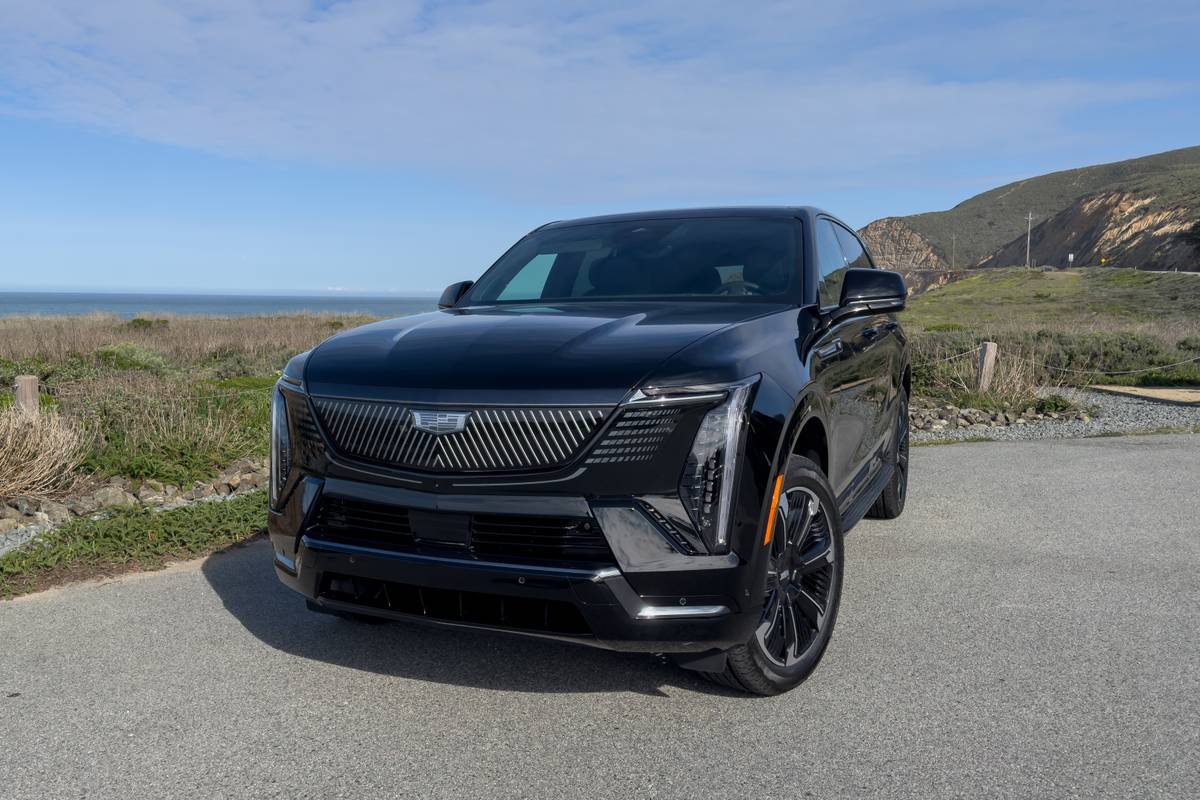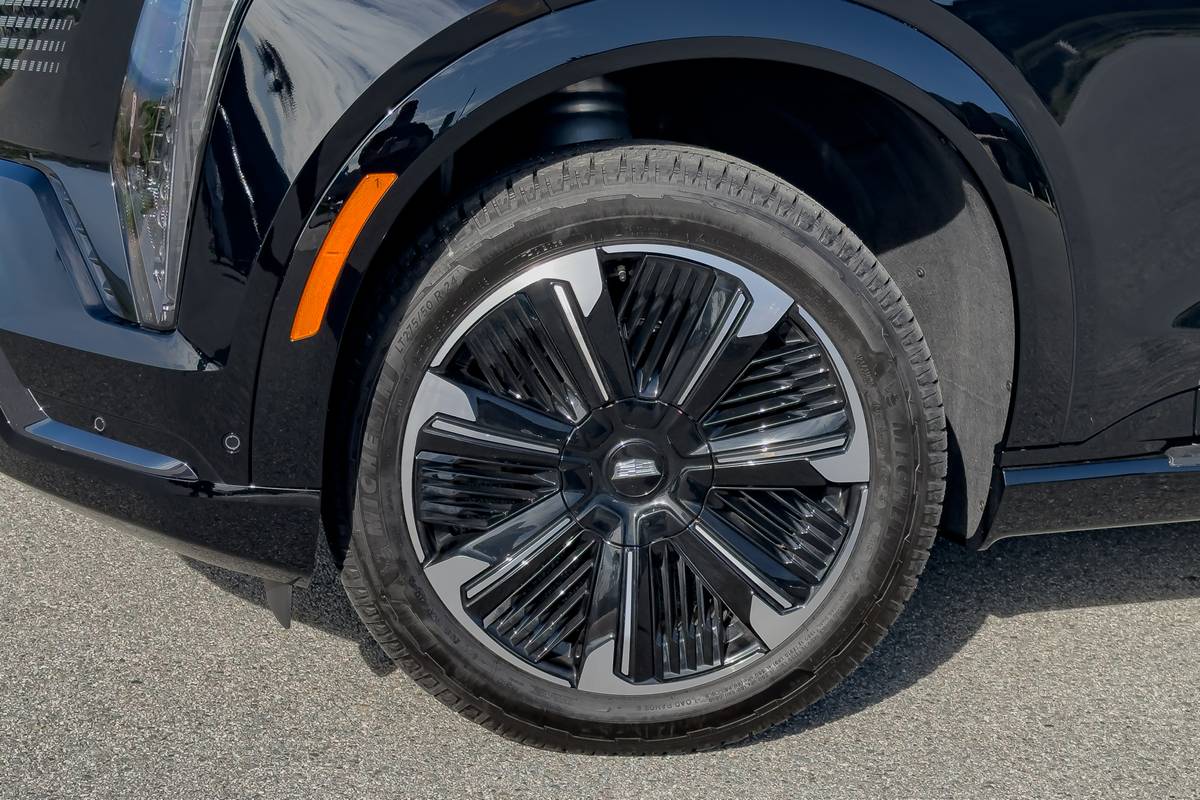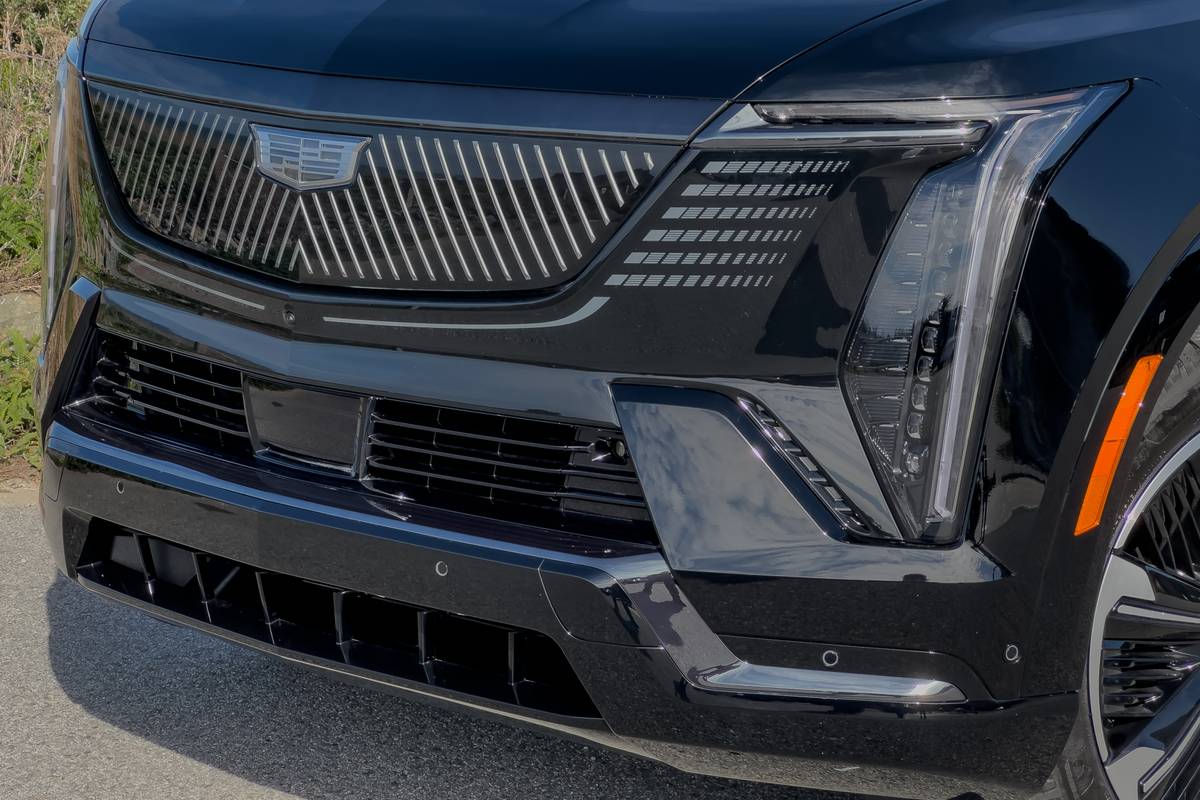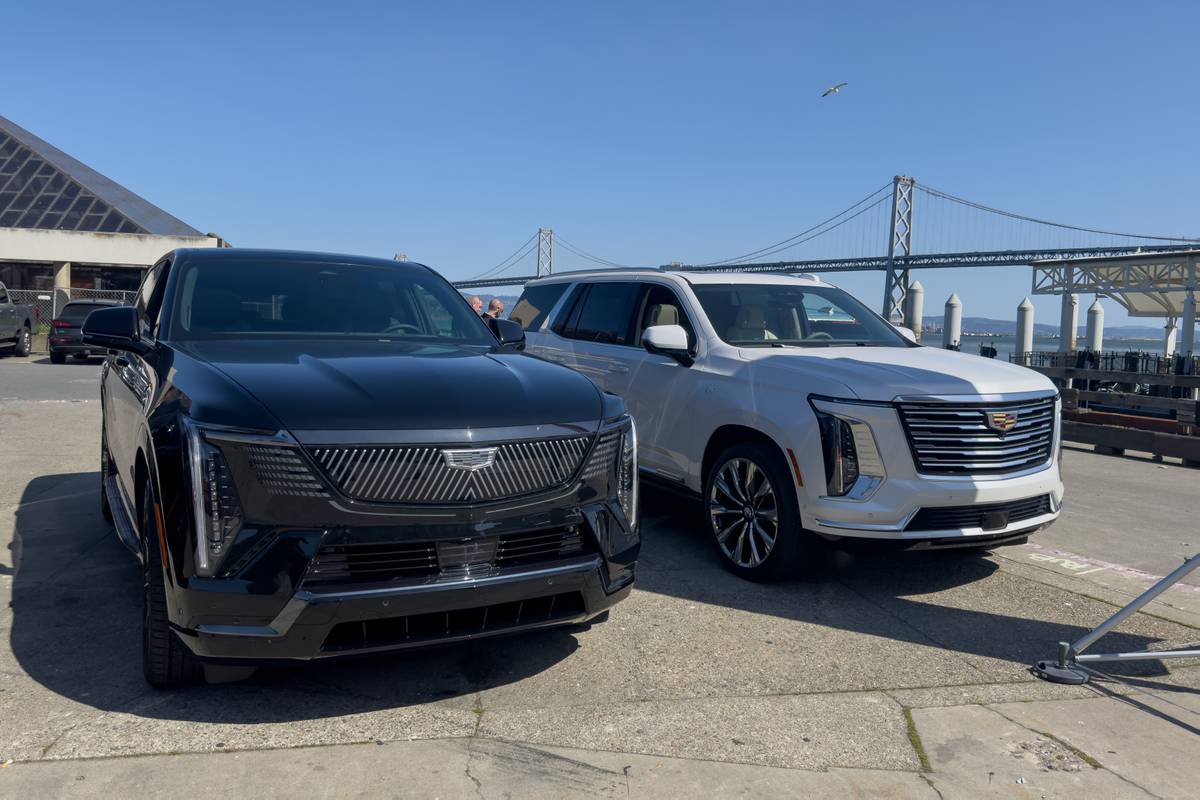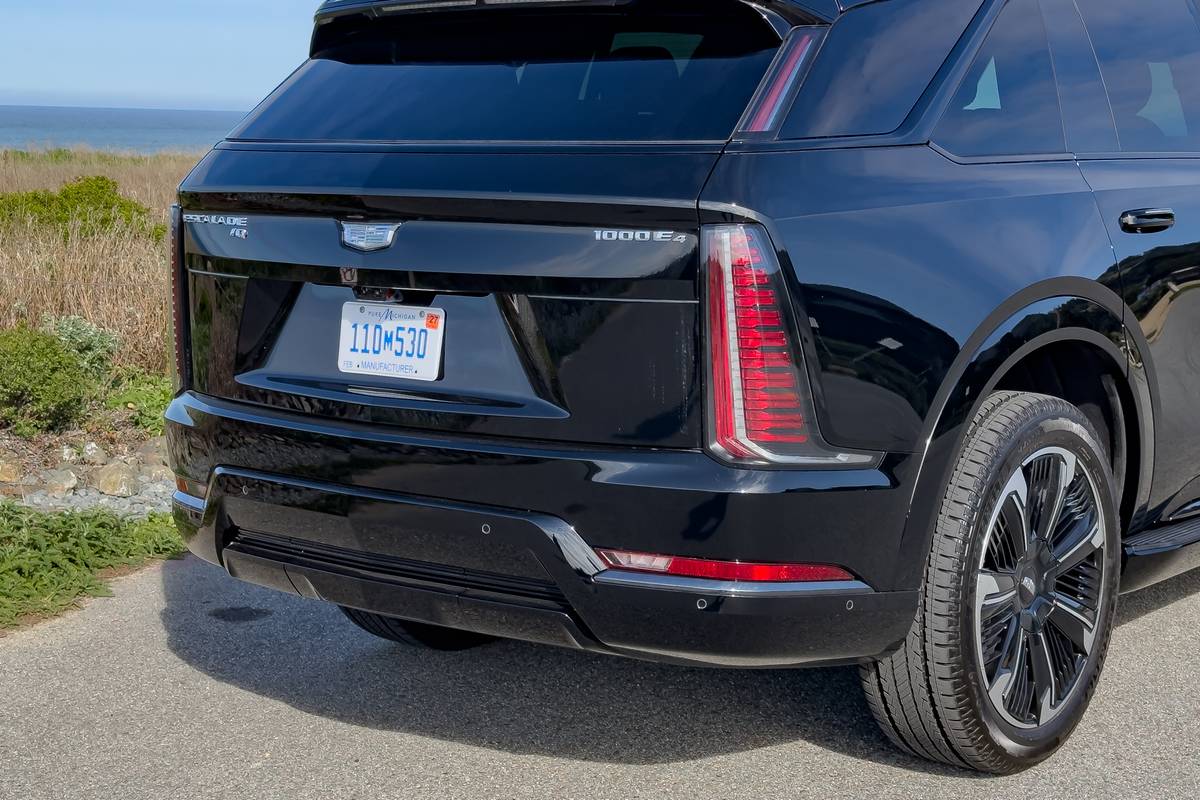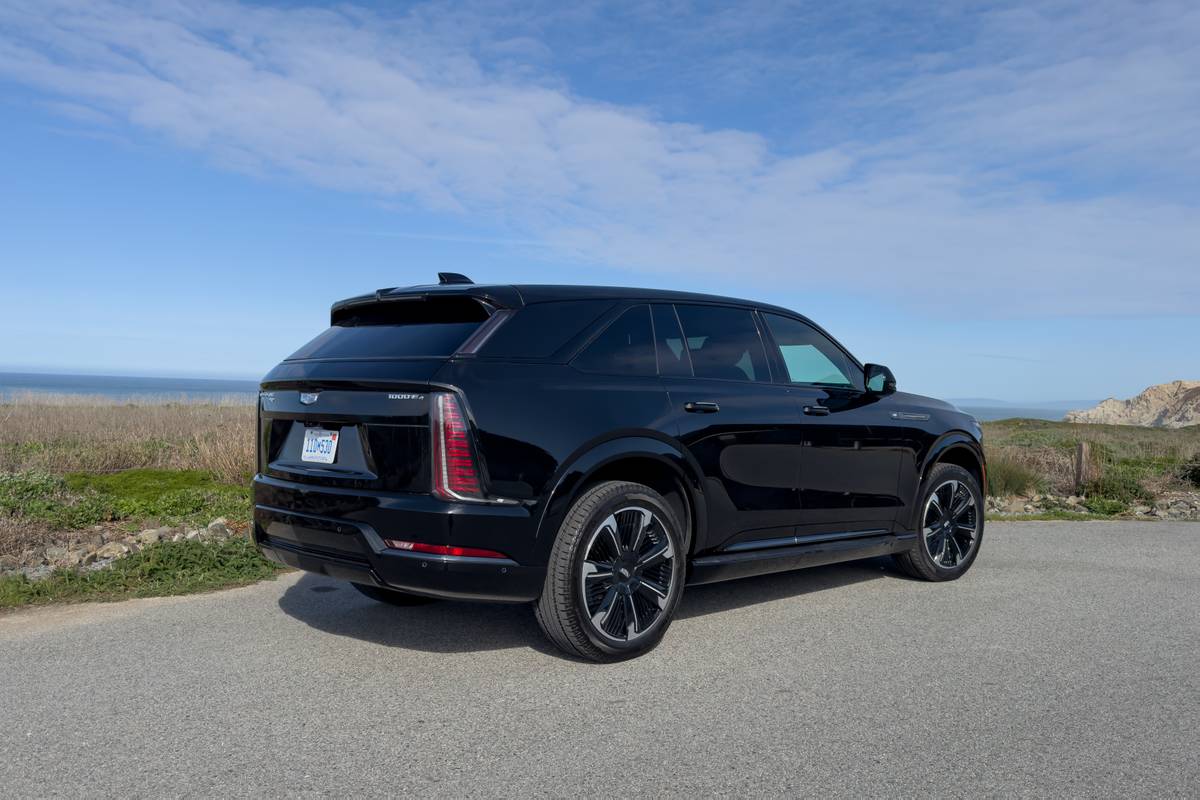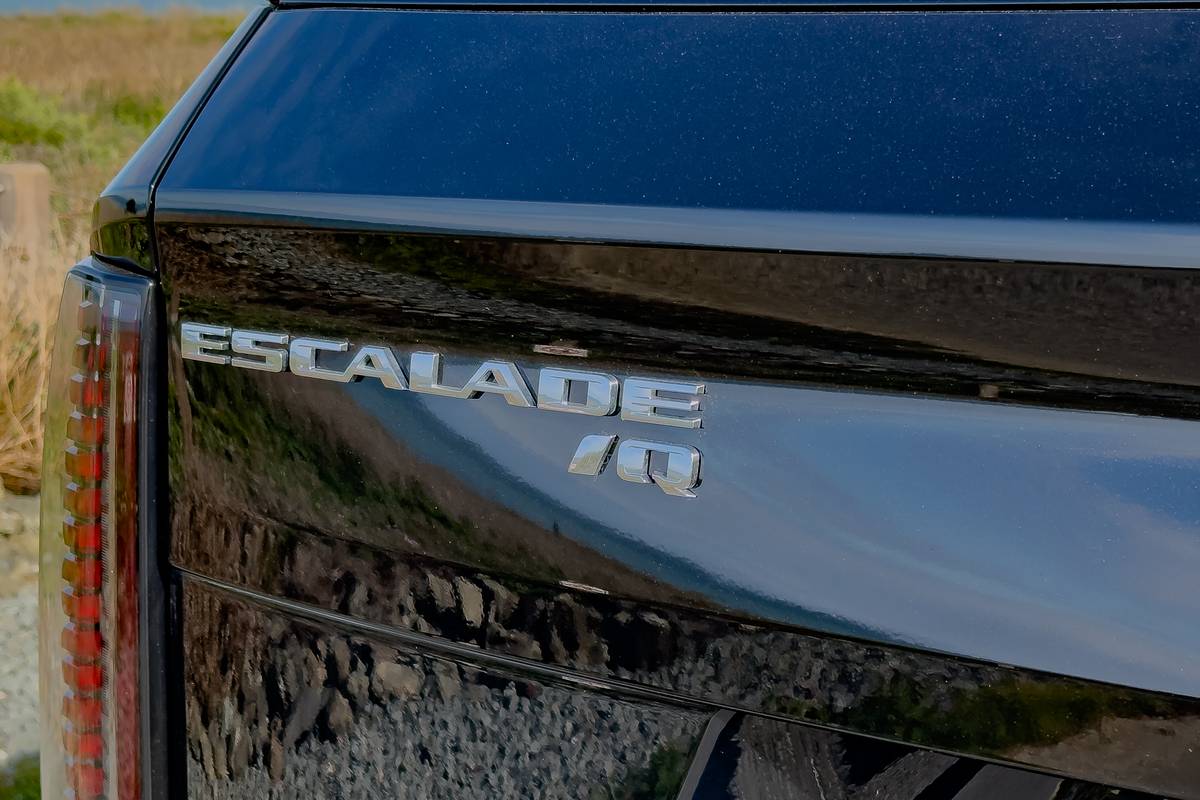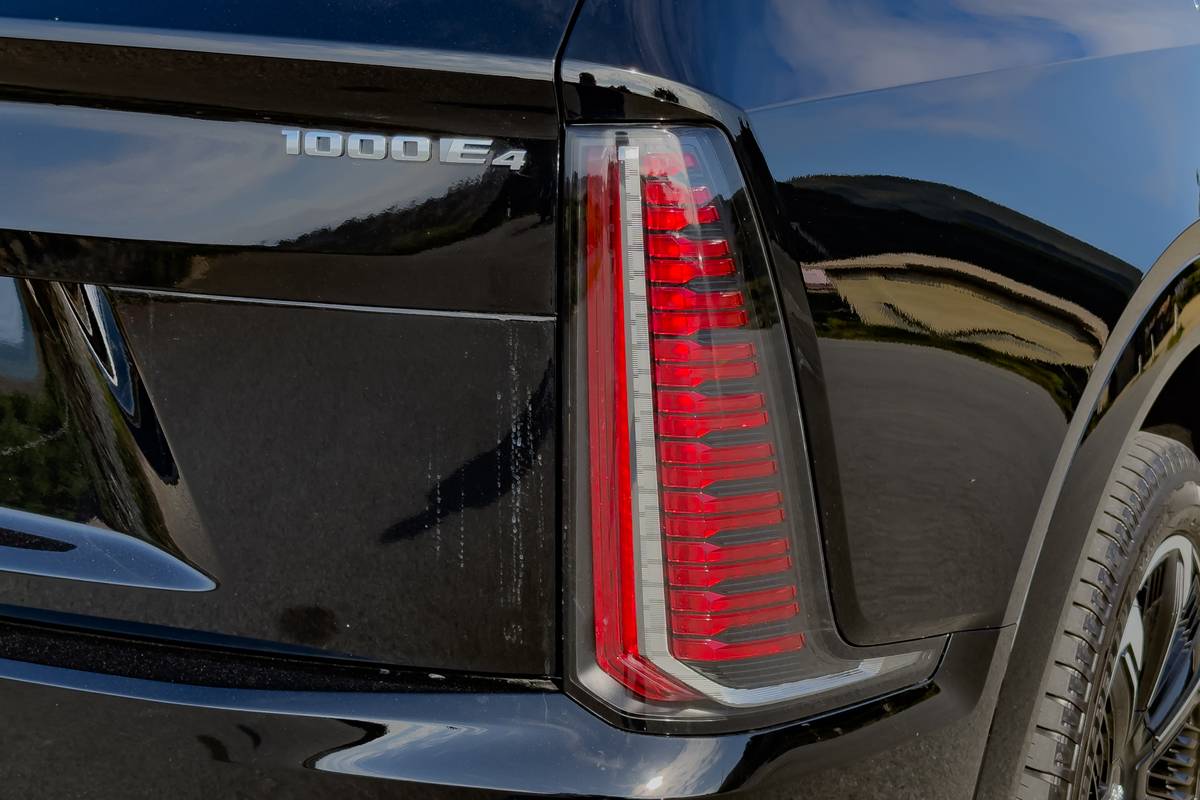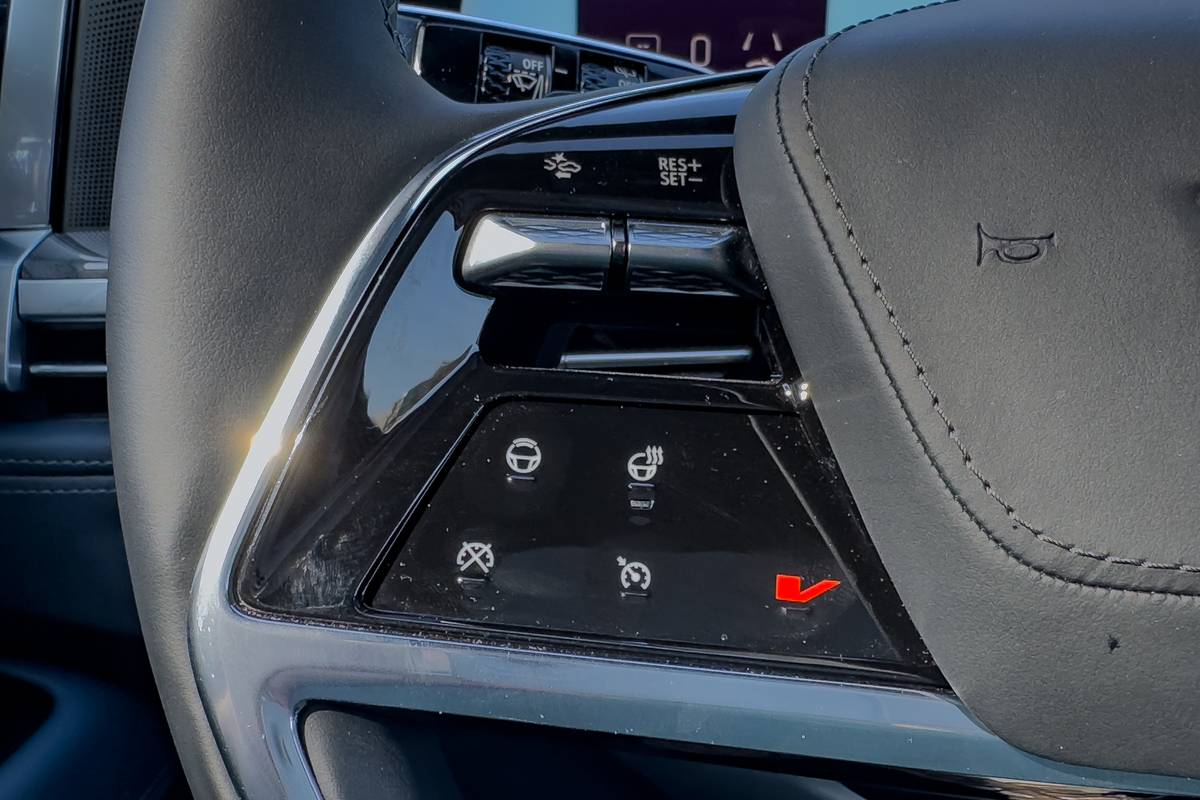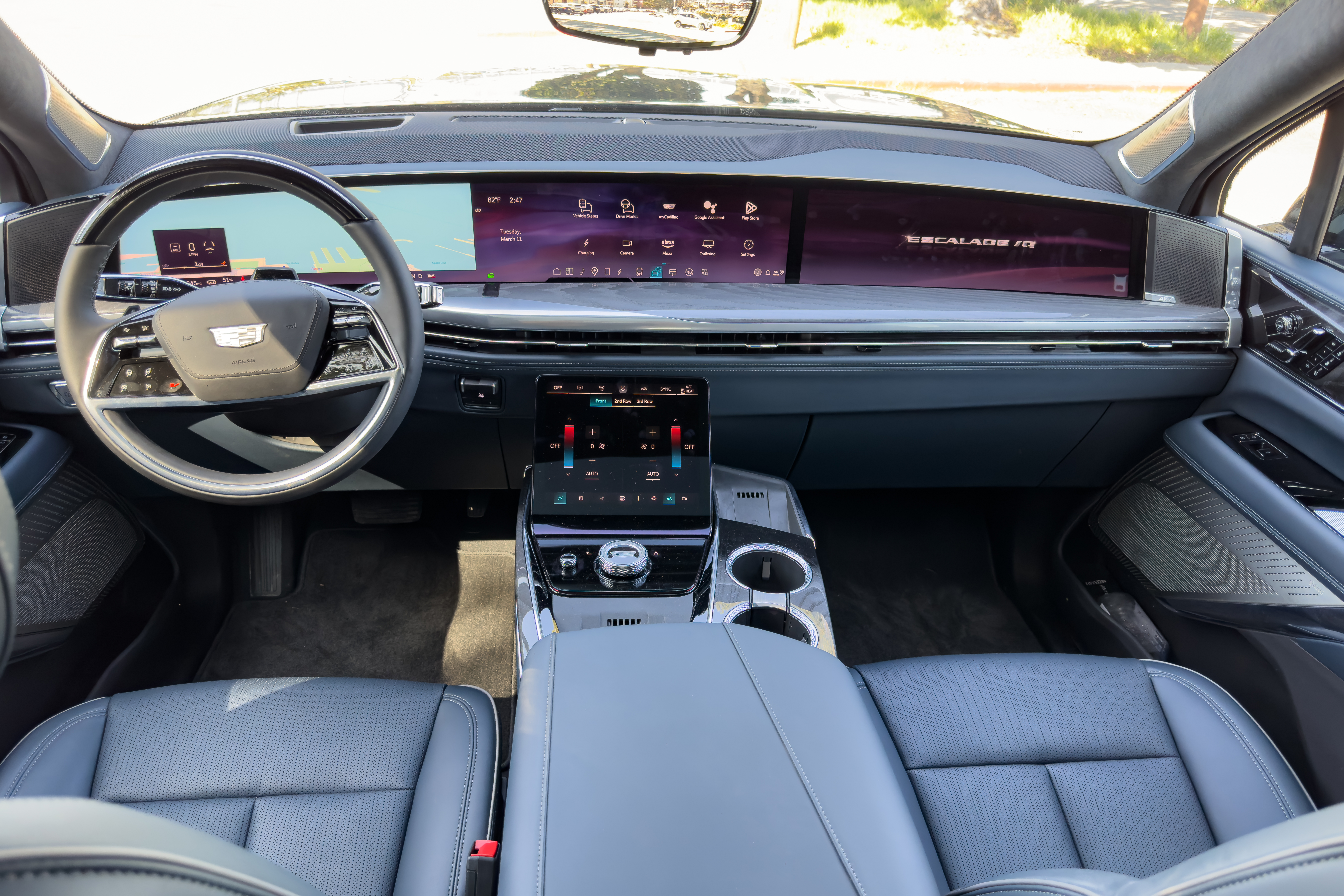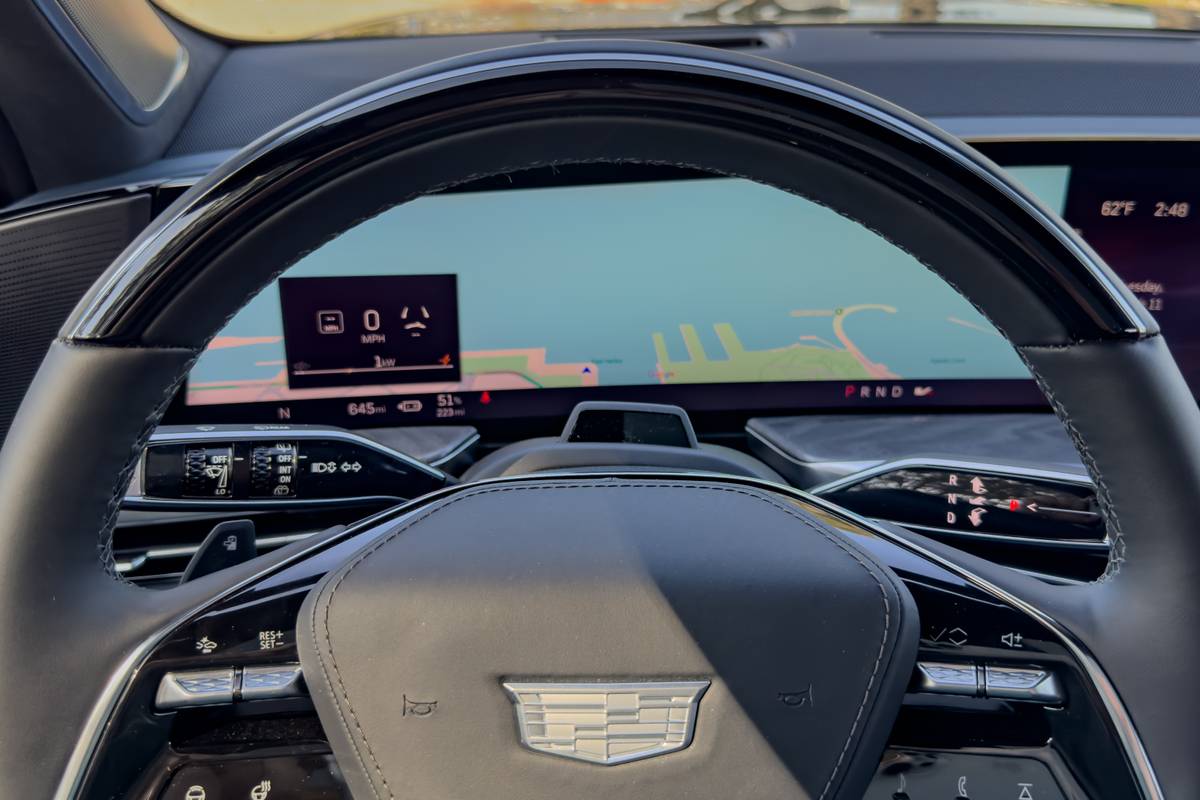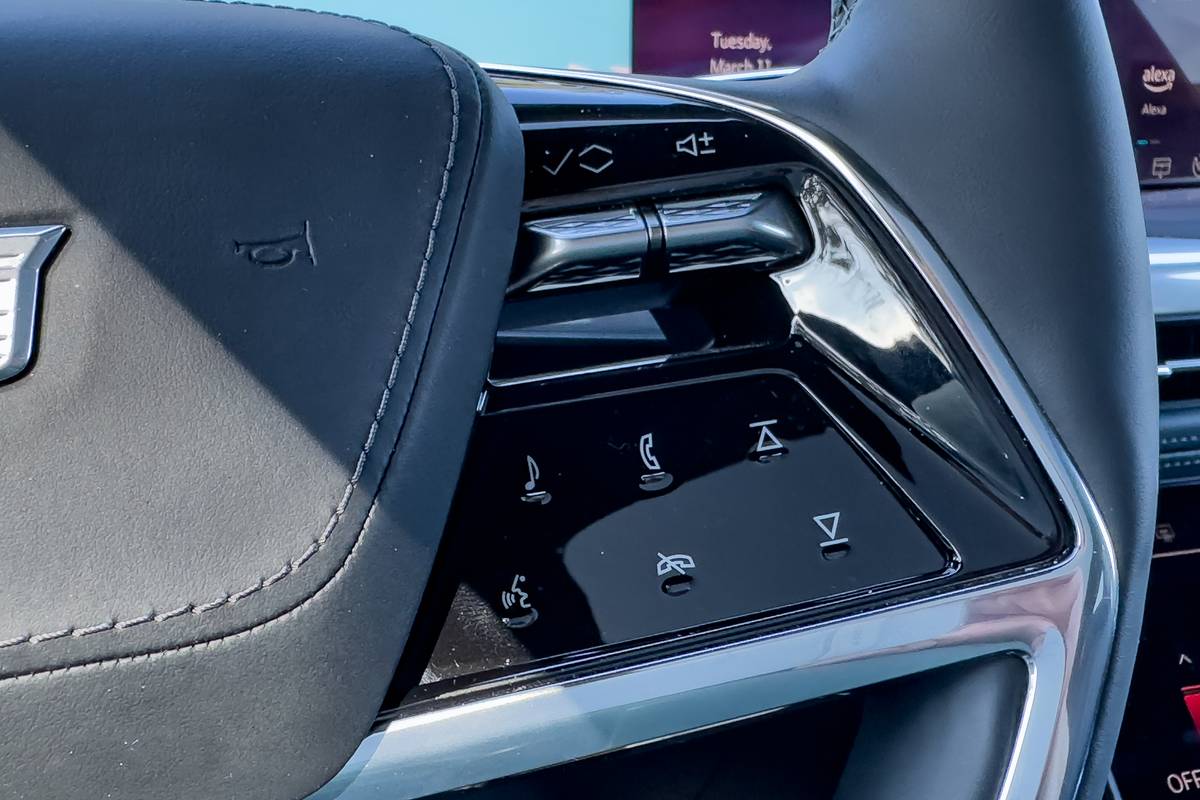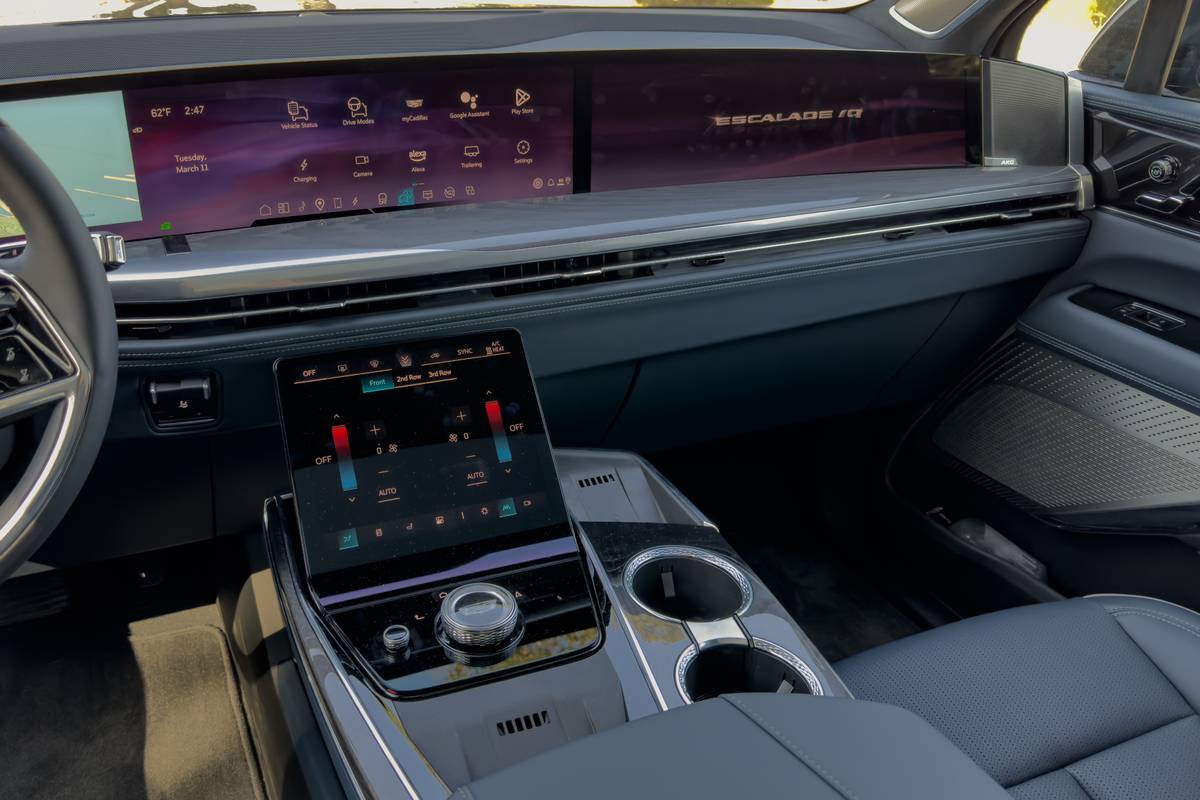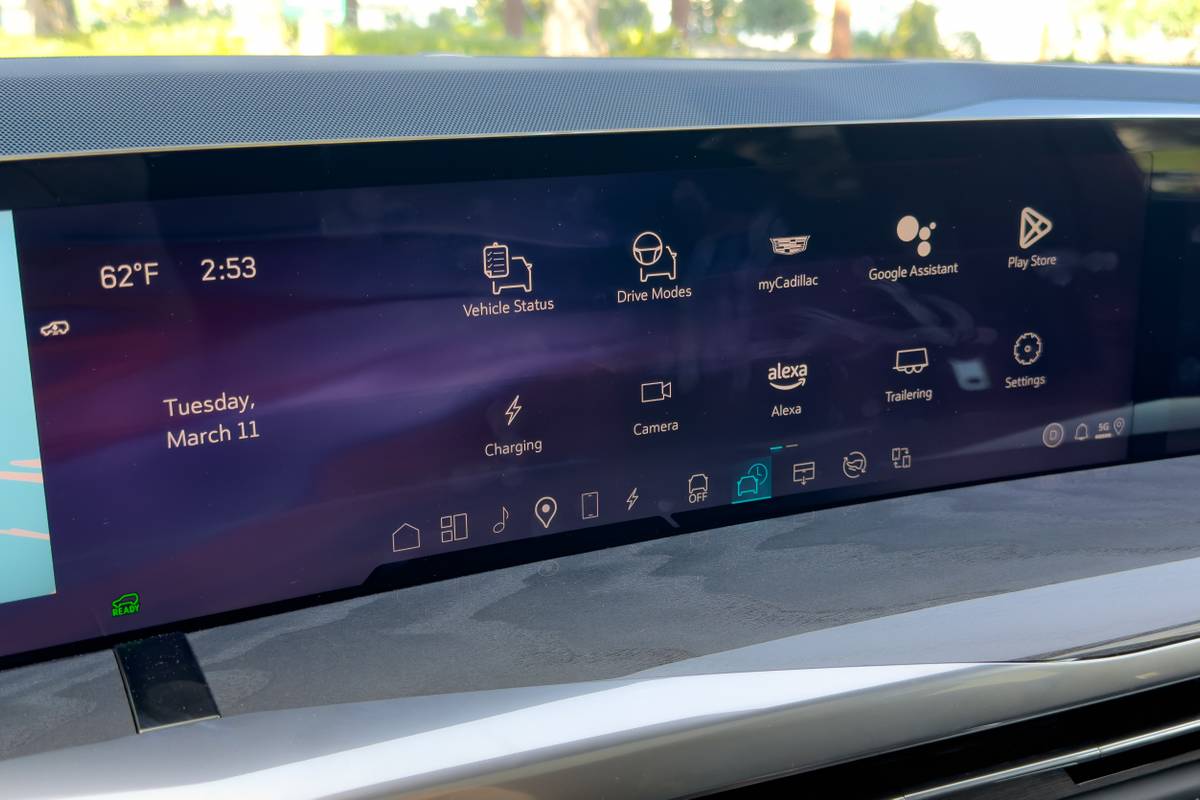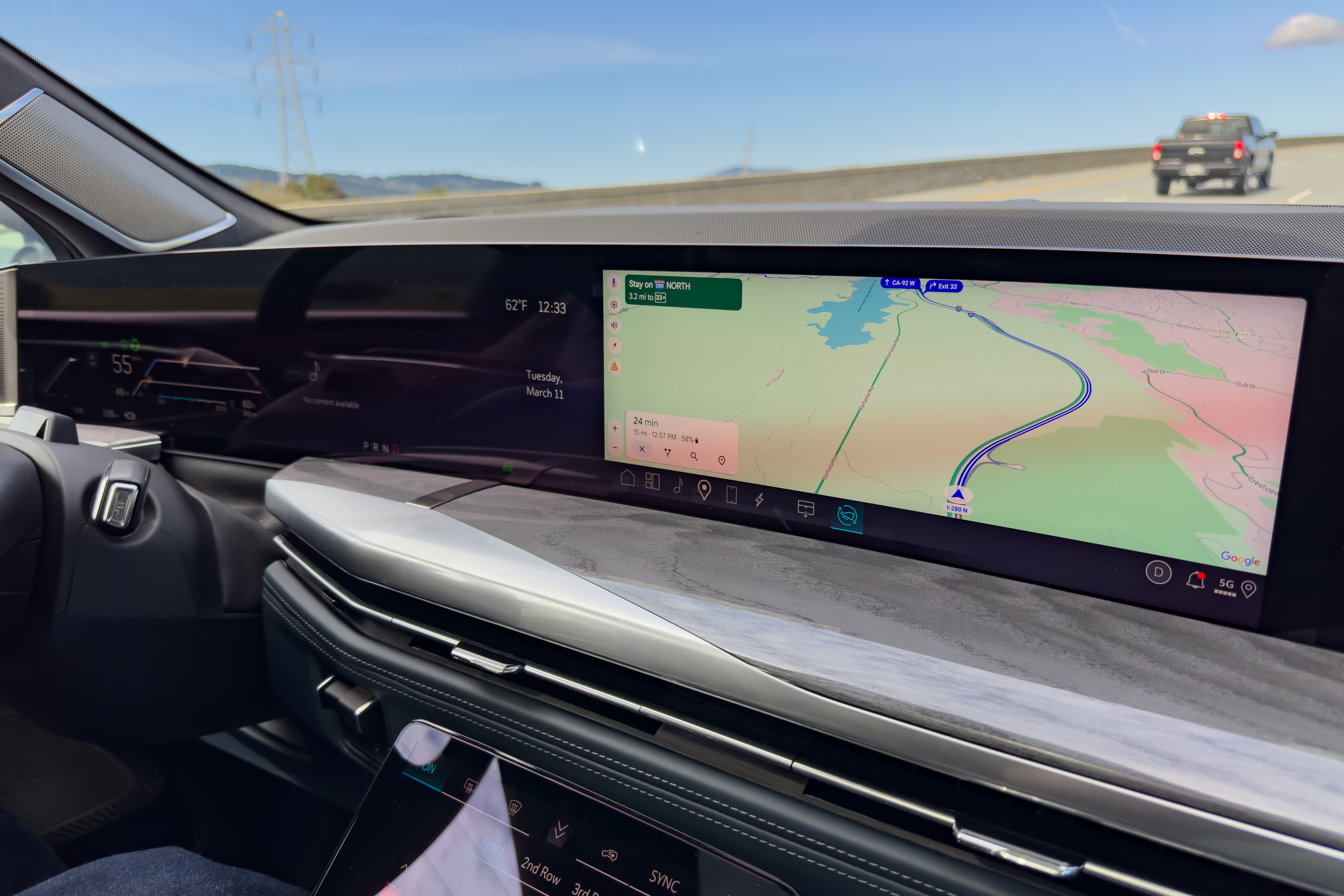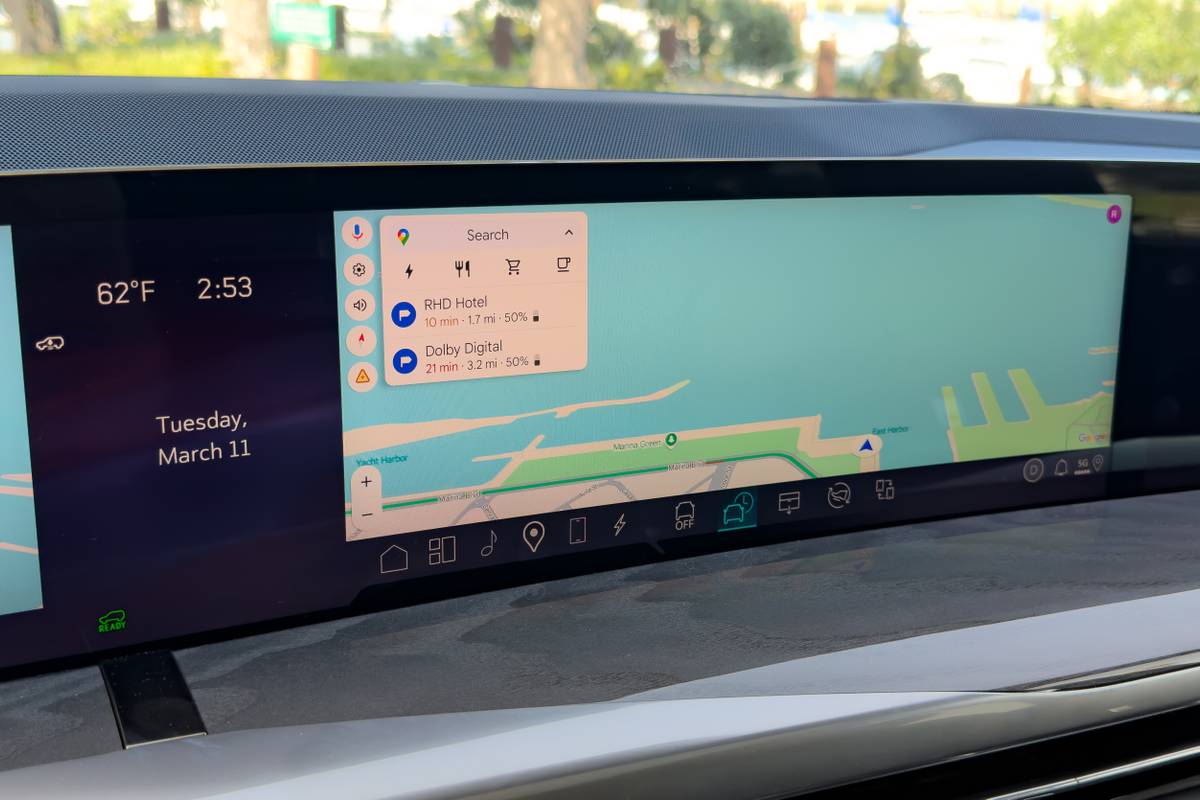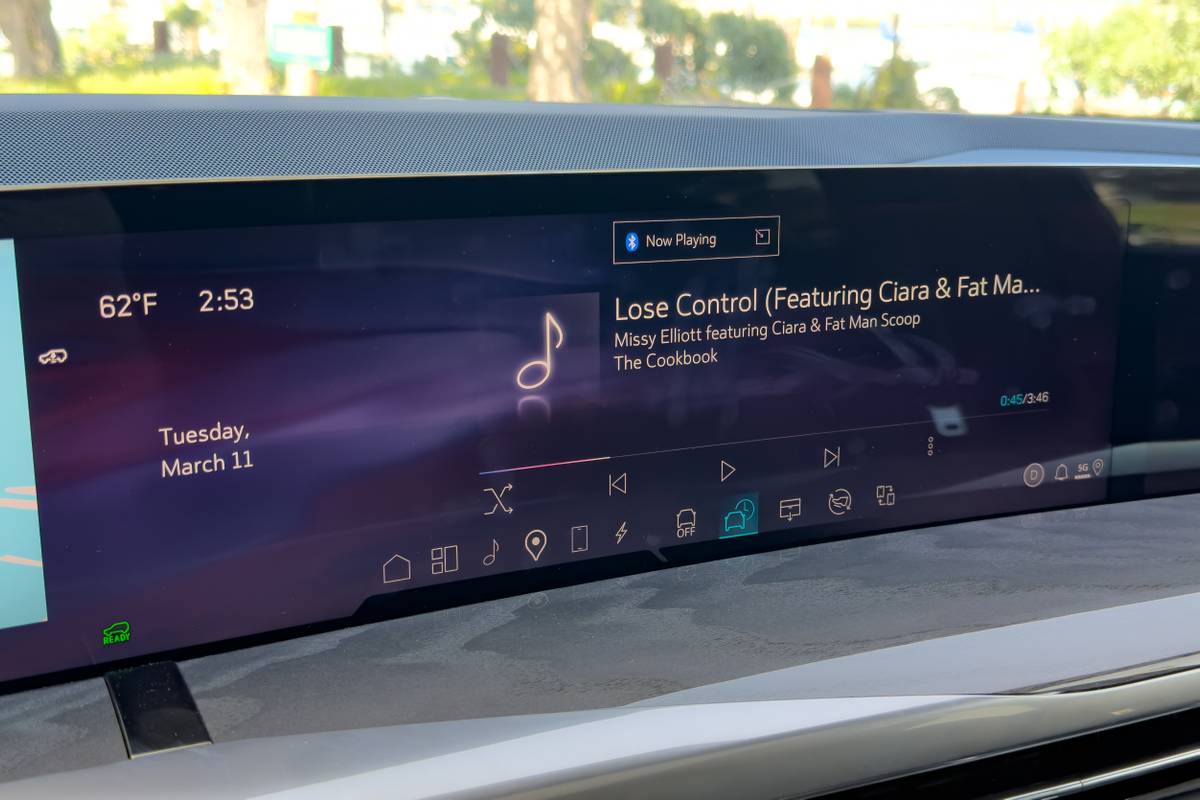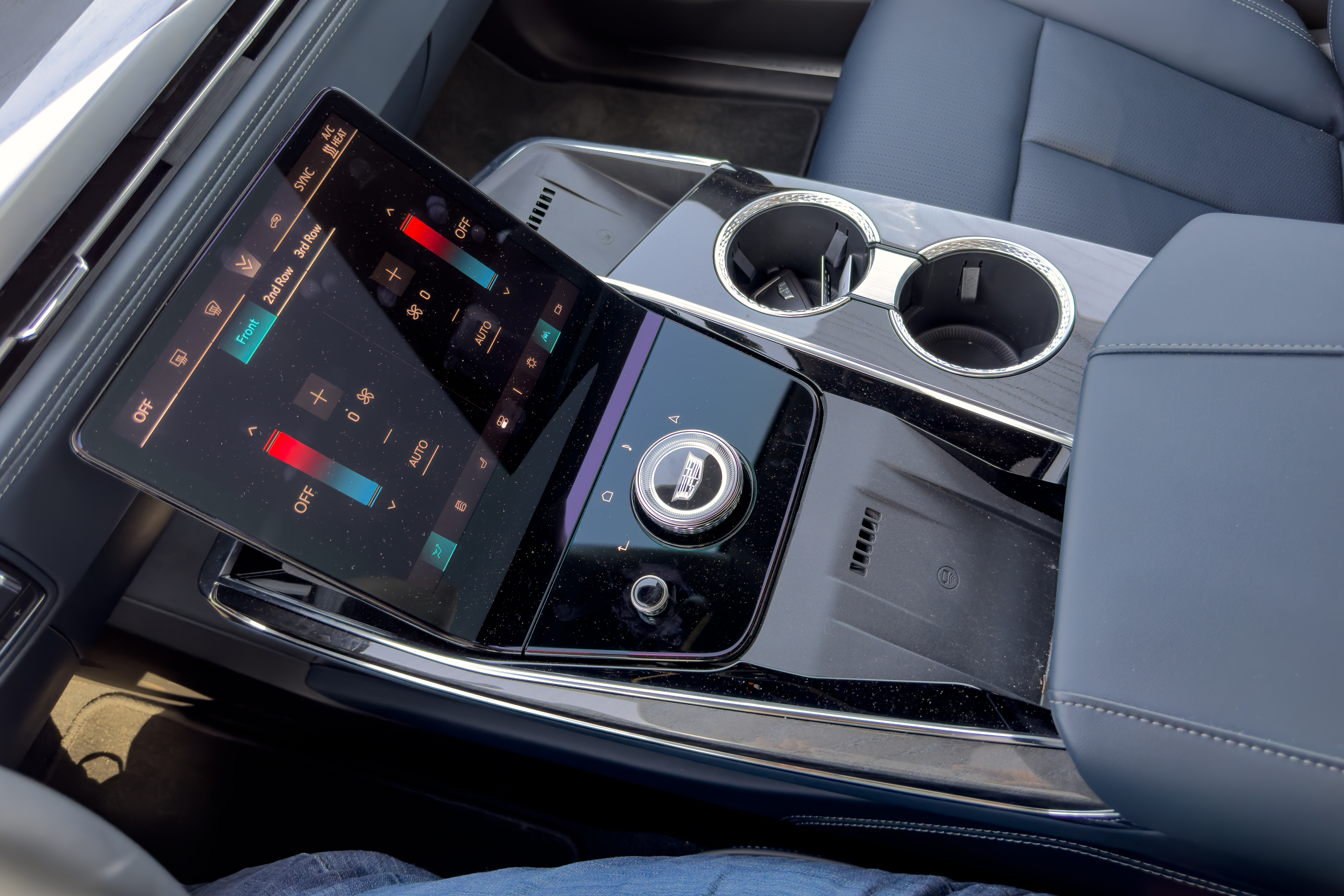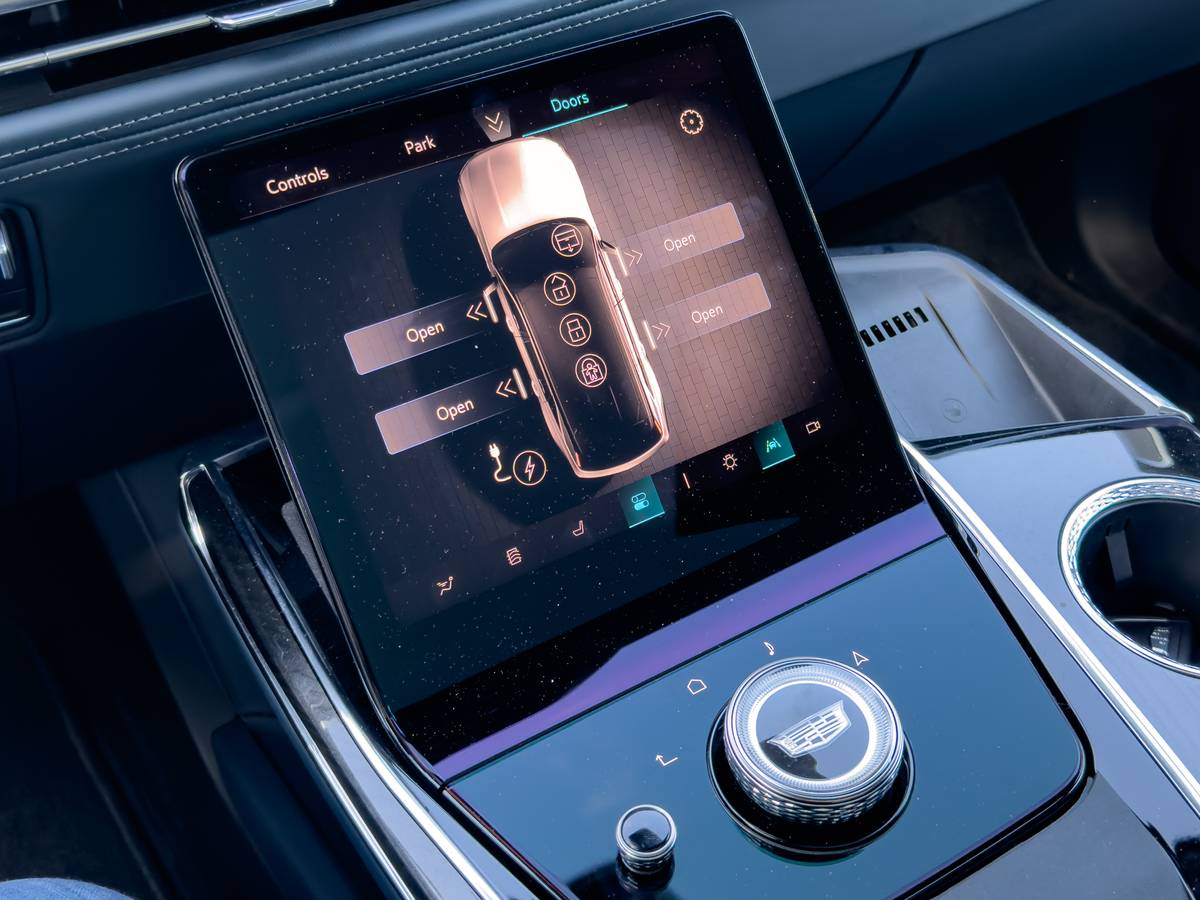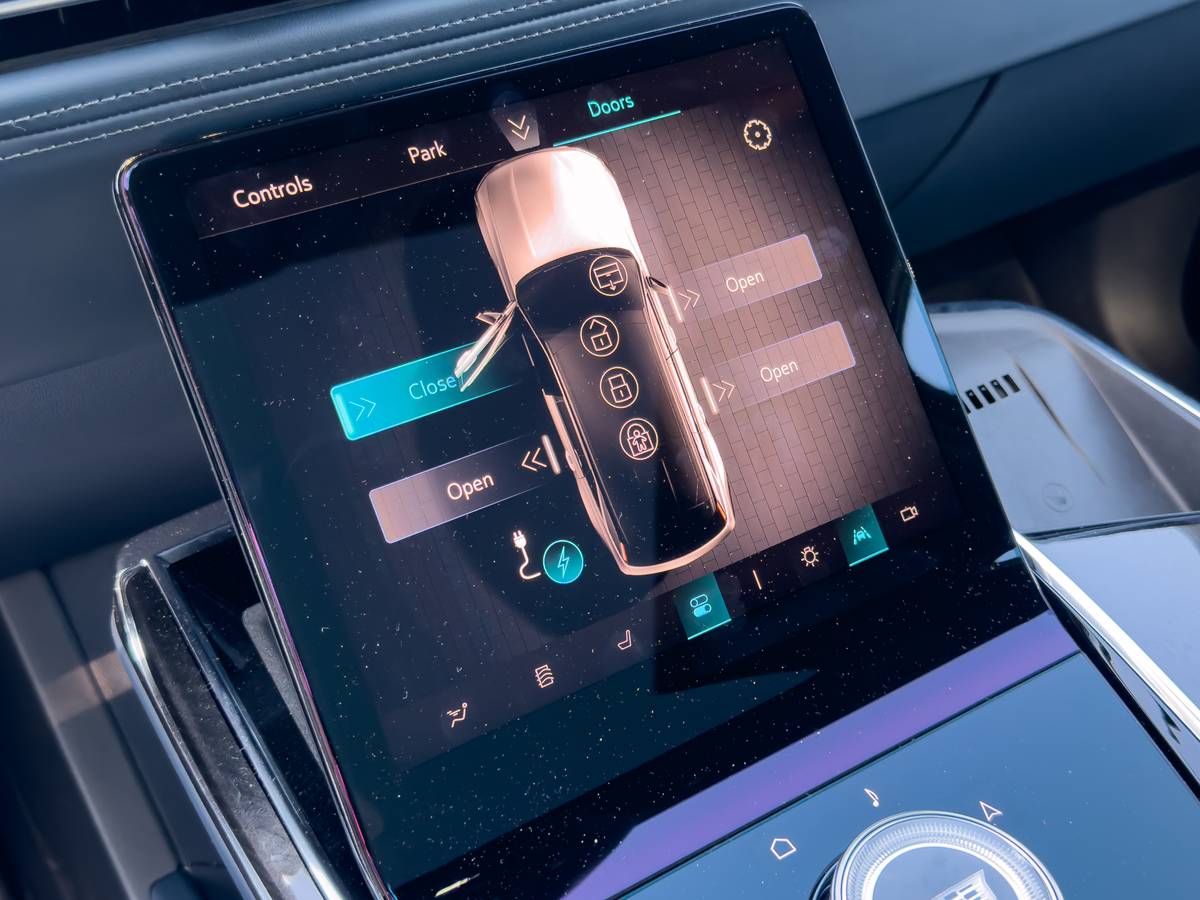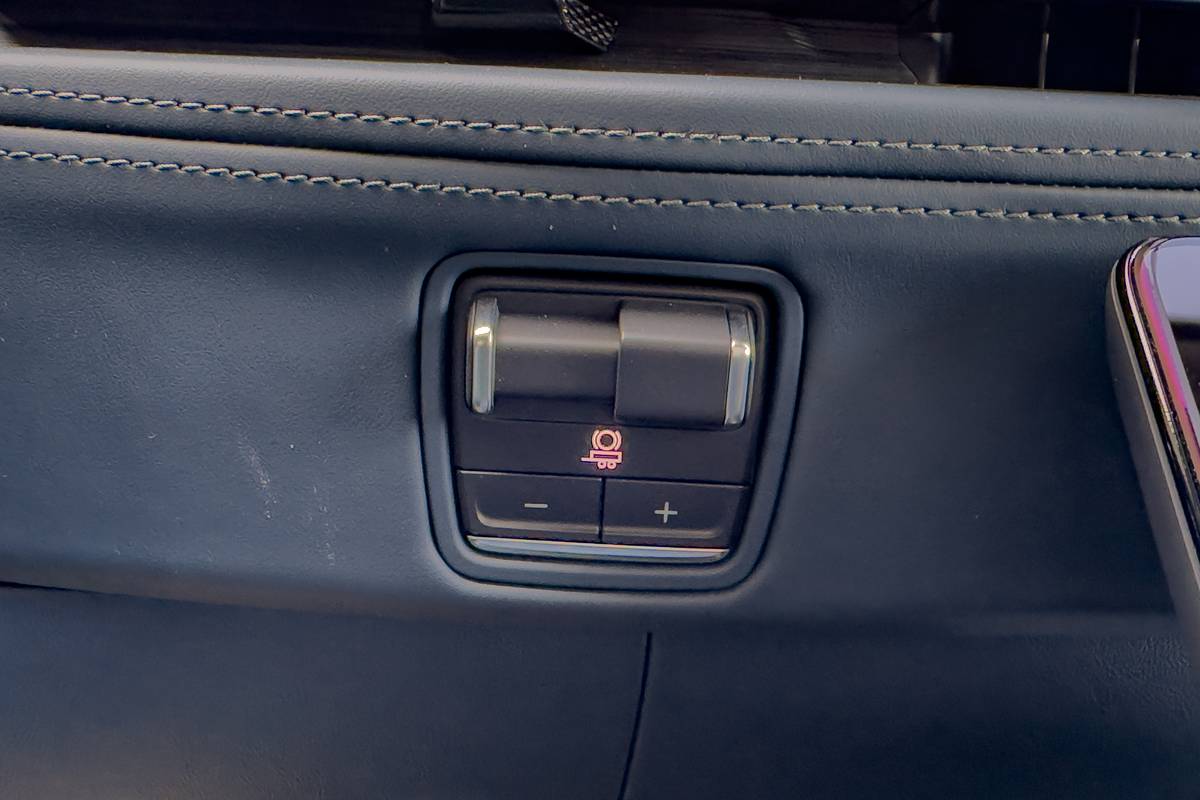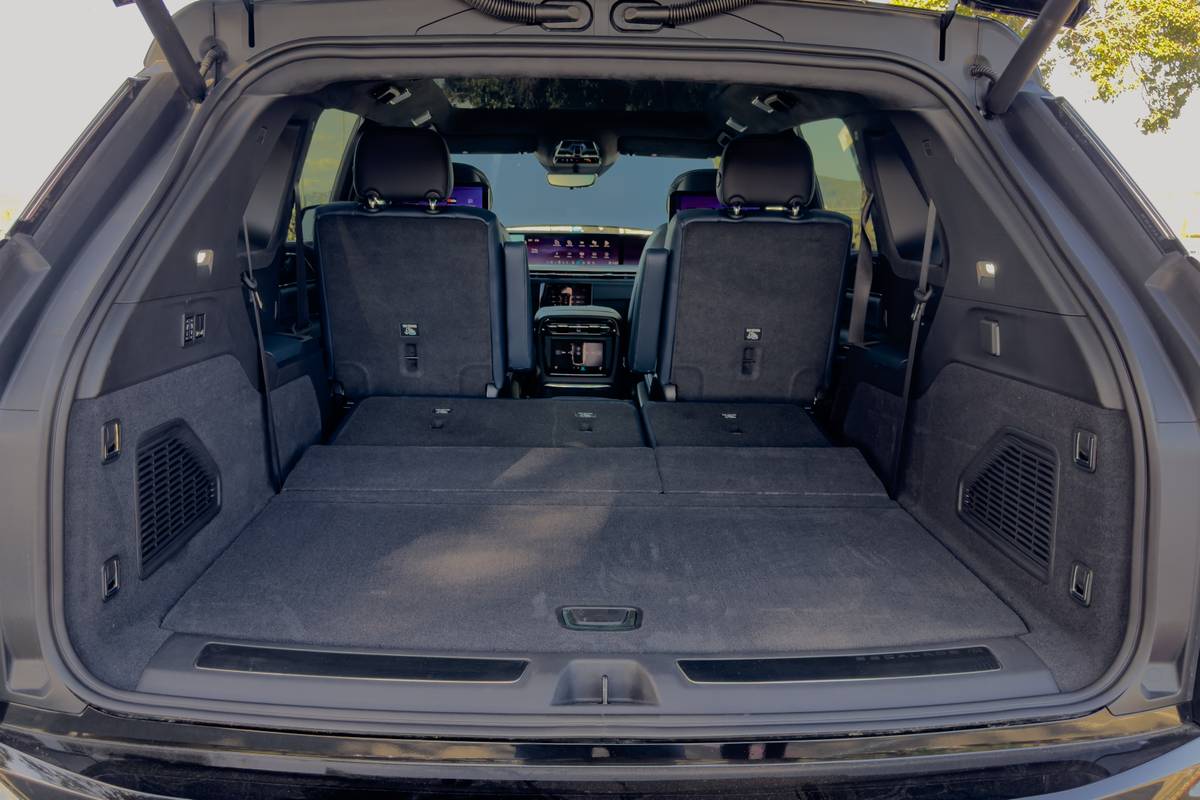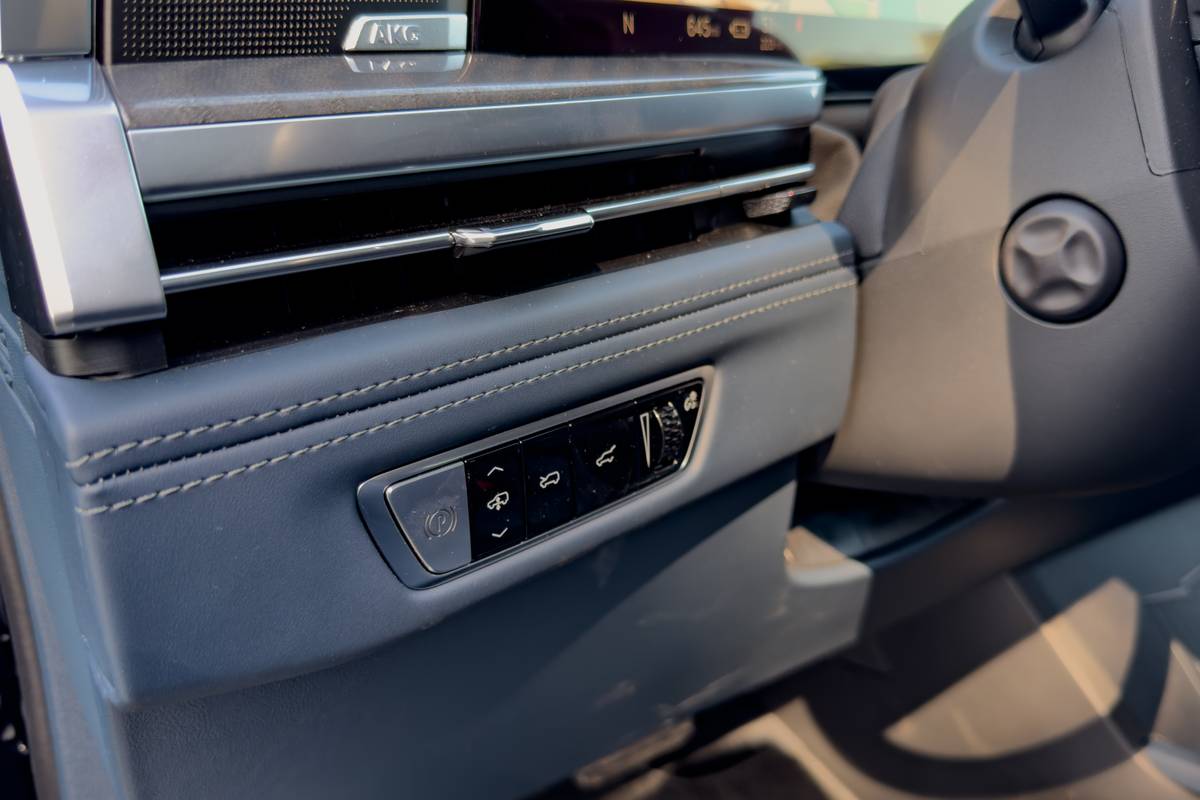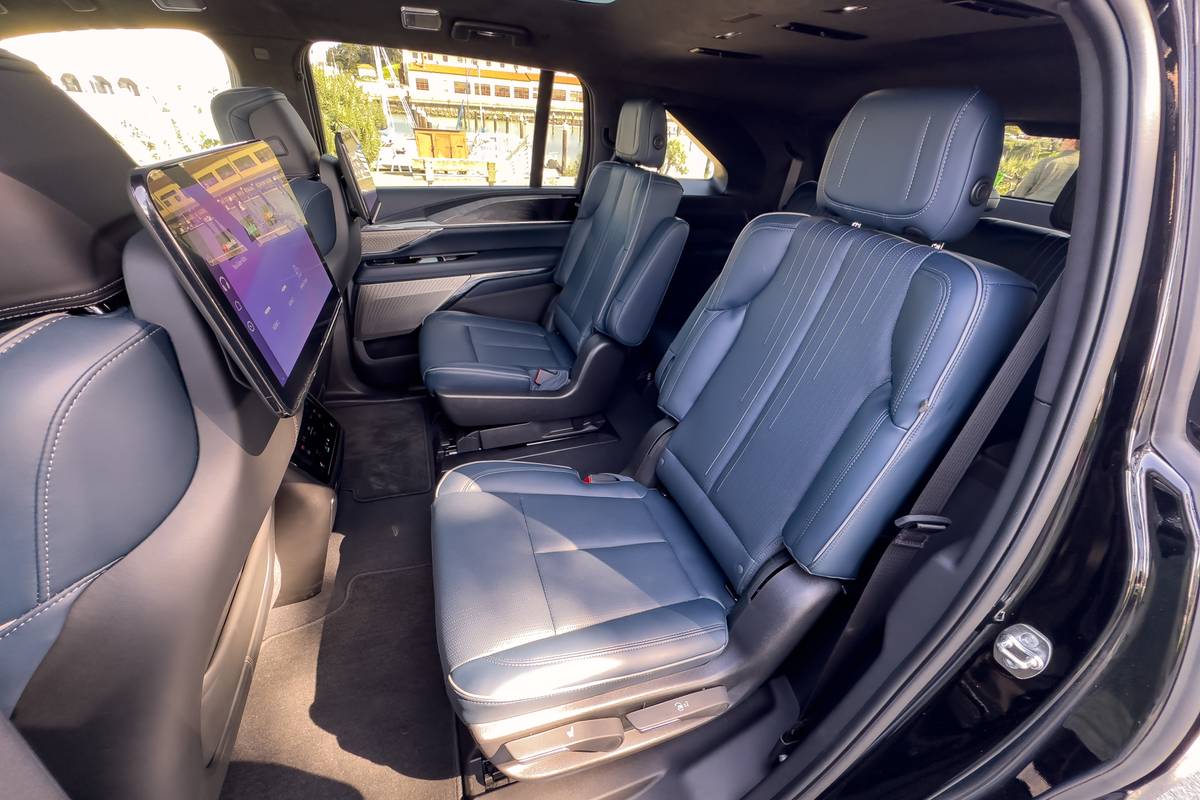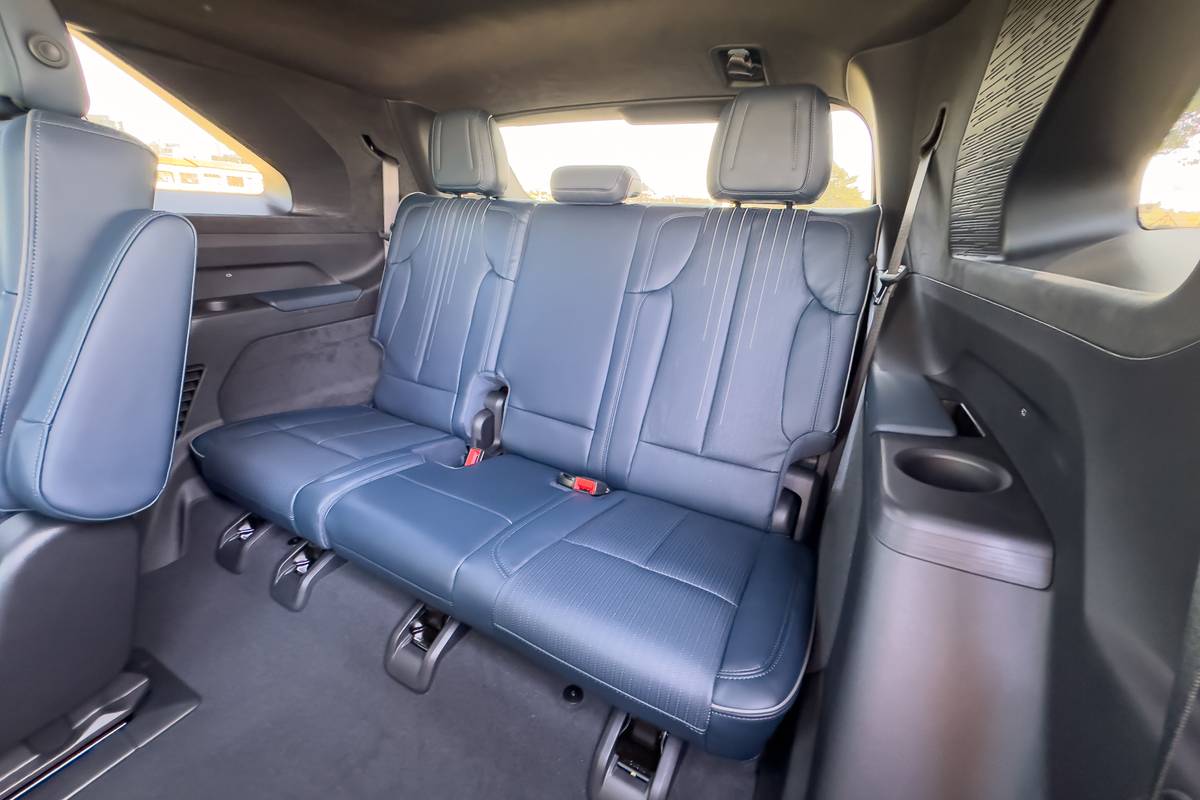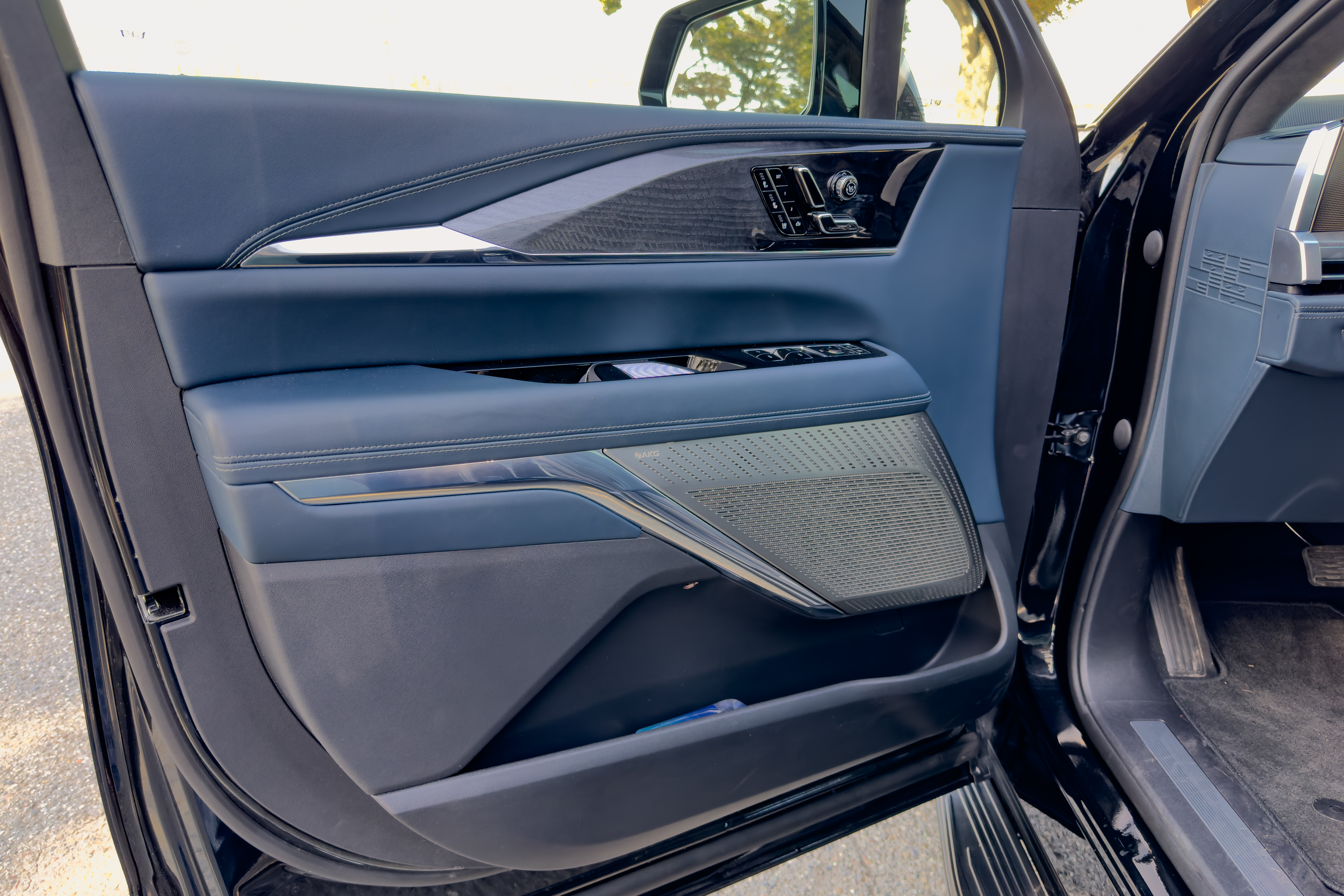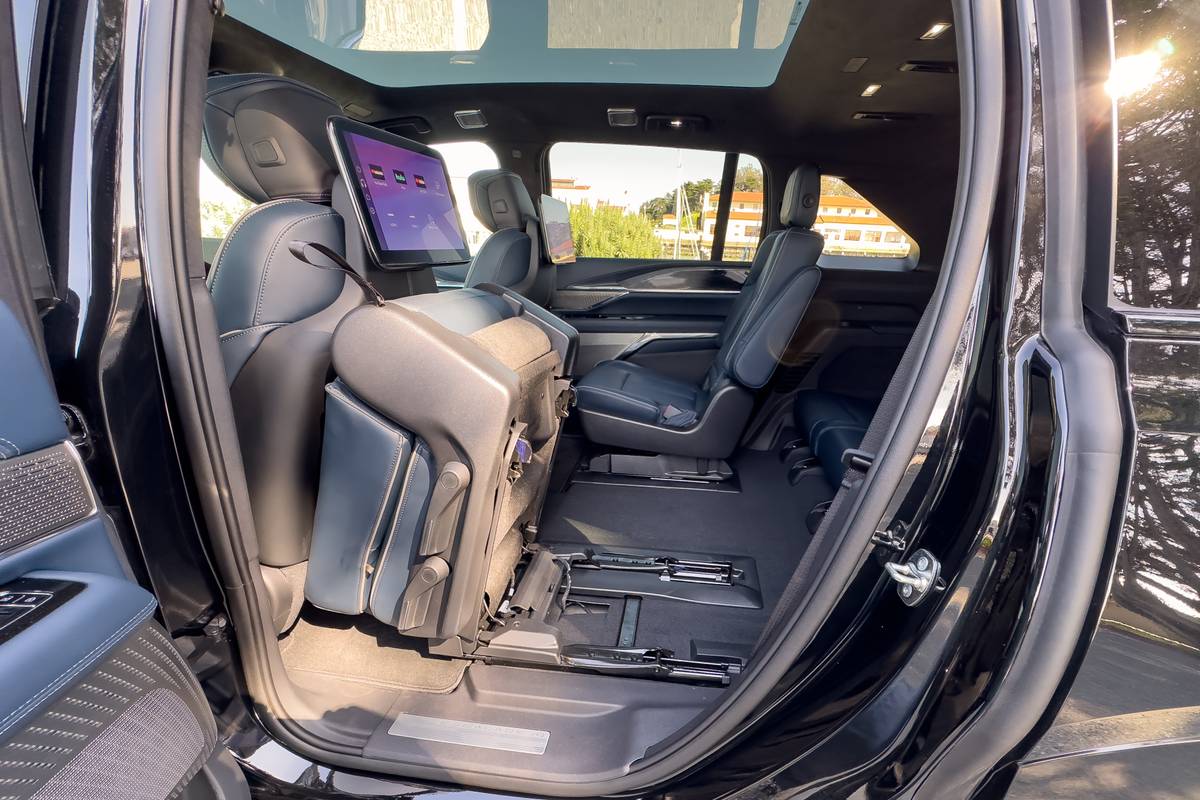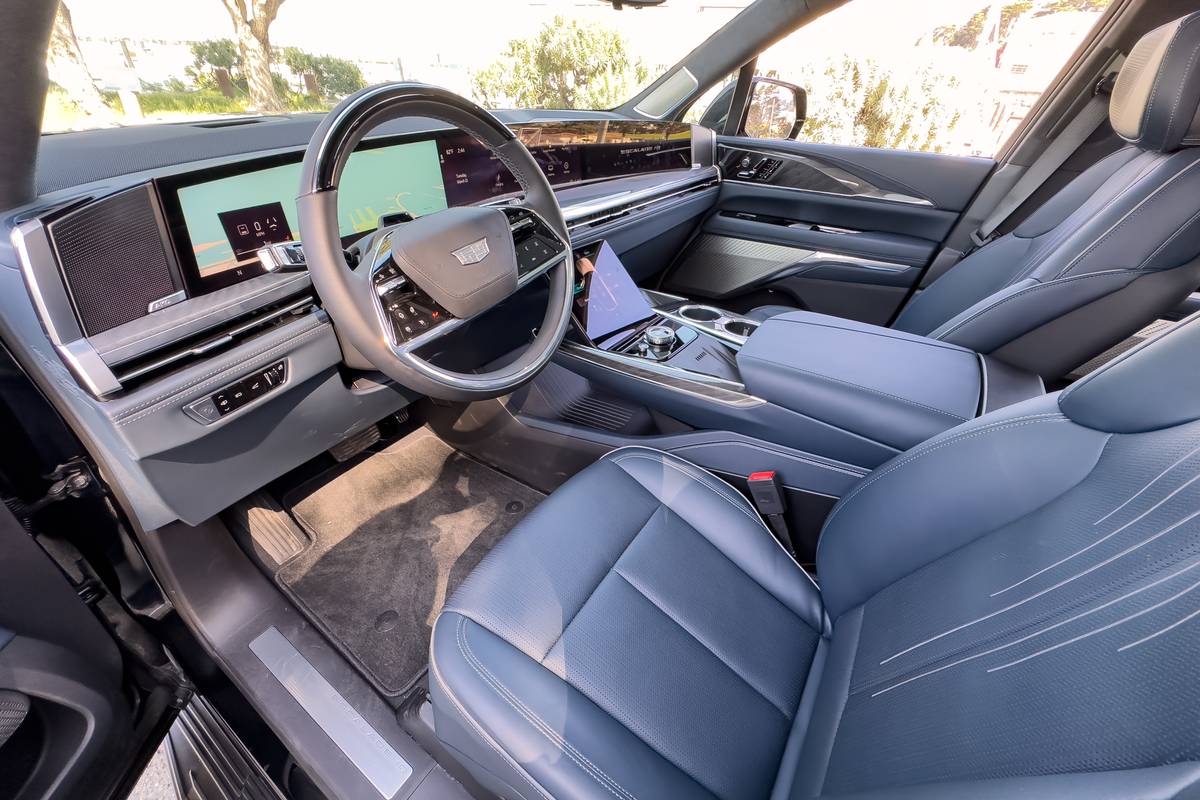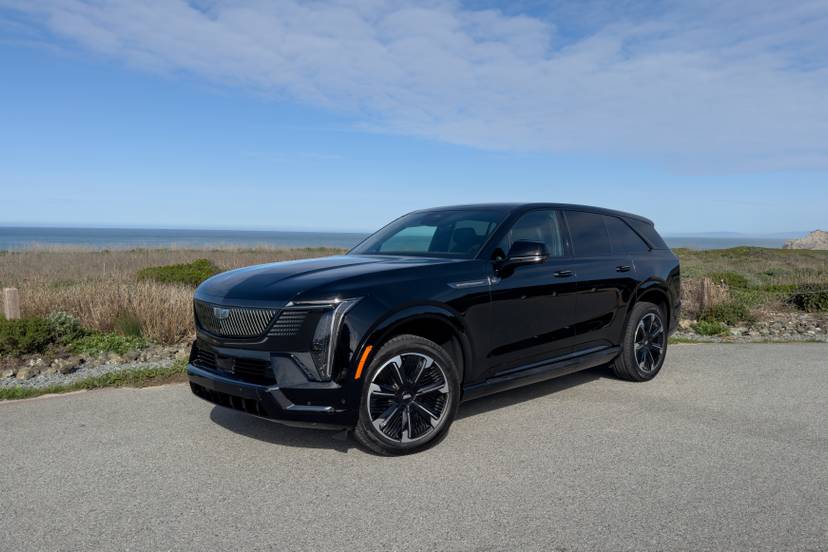
Is the Cadillac Escalade IQ a Good Car?
- The all-new 2025 Cadillac Escalade IQ electric luxury SUV prioritizes style and technology over usable space, with a focus on the driver and executive passengers rather than those in the rearmost seats.
How Does the Cadillac Escalade IQ Compare With Other Electric SUVs?
- The Escalade IQ is bigger, heavier and less efficient than competitors like the Lucid Gravity or Mercedes-EQ EQS SUV, but it has a longer estimated driving range due to its massive 200-plus-kilowatt-hour battery pack.
The massive SUV you see here that you can buy right now, the 2025 Escalade IQ, is a product of Cadillac’s previously stated movement toward an electrified future, created when GM said that the future of the luxury brand was going to be purely EVs. Cadillac now says that a balanced portfolio of both gasoline and electric products is where its future lies (wise given the continued slow adoption of EVs in North America for various reasons), so you can either have a gas-powered Escalade (also available in an ESV extended-length version) or this new electric Escalade IQ (soon to be available in IQL extended-length form).
But is the American luxury buyer ready for an electric Escalade? Can the iconic epitome of American blingy excess attract buyers if you take away the snorty, powerful V-8 engine? I say it can — but it’s going to take some convincing, and possibly a tweak to who it’s aimed at.
Related: 2025 Cadillac Escalade IQ Up Close: More Lyriq XL Than Escalade EV
How Much Does the Cadillac Escalade IQ Cost?
You thought the GMC Hummer EV SUV was expensive? Boy, you ain’t seen nothing yet. Starting prices for all of the Detroit-made 2025 Cadillac Escalade IQ trim levels are as follows (all prices include an absolutely staggering $2,290 destination fee):
- Escalade IQ Luxury 1: $129,990
- Escalade IQ Sport 1: $130,490
- Escalade IQ Luxury 2: $149,990
- Escalade IQ Sport 2: $150,490
How does that stack up against competing electric luxury three-row SUVs? The 2025 Lucid Gravity Grand Touring’s $96,550 starting price is more than $30,000 less than a base Escalade IQ, and even loaded up with every option, the Lucid is still less than the entry-level Escalade IQ. The Mercedes-EQ EQS SUV also starts well below the Escalade IQ with a base price of $106,400, but it can be optioned up to match or exceed the Cadillac’s pricing, especially if you specify the Maybach trim, which starts at $181,050.
Even when compared with Cadillac’s own gas-powered Escalade, the IQ starts well north of where the dinosaur-powered model does; the least expensive rear-wheel-drive Escalade starts at $90,095, while the cheapest four-wheel-drive model adds $3,000 to that price. But when you consider that a fully loaded, gas-powered 2025 Escalade (and not even the extended-length ESV version) can sticker north of $144,000 and that Cadillac still sells tons of them, maybe the Escalade IQ’s pricing isn’t as much of a hindrance as it might initially appear.
How Does the Cadillac Escalade IQ Drive?
GM has been doing an amazing job crafting mammoth electric SUVs and making them feel considerably smaller, lighter and more nimble than their specs would suggest — and the new Escalade IQ is the latest impressive effort. In fact, it might be the best example yet of GM’s full-size electric vehicles when you consider the other vehicles that share its platform: the GMC Hummer EV Pickup and SUV and the GMC Sierra EV and Chevrolet Silverado EV pickup trucks. The Escalade IQ features a few things that help tame its mass, like the latest Magnetic Ride Control 4.0 shock absorbers, adjustable-height air springs, and a general focus on refinement and luxury motoring over off-road readiness or cargo hauling.
It shows up in the Escalade IQ’s body control, which is the best of the big EV lot. It exhibits none of the tippiness or body dip and rocking experienced in the Hummer EV SUV. The low center of gravity provided by the massive battery under the floor combines with the magical Magnetic Ride Control system and the standard four-wheel steering to maintain a level of comfort, control and refinement that truly impresses.
That four-wheel steering might just be the Escalade IQ’s best feature, with up to 10 degrees of rear steering that allows for a 39.4-foot turning circle that’s less than a foot and a half larger than a Chevrolet Equinox EV’s. It makes urban maneuvers a breeze, and it also enables something Cadillac calls Arrival Mode, which GMC Hummer EV fans will know as CrabWalk. Push a few buttons and all four wheels turn in the same direction, allowing for diagonal movement. It’s still only really useful as a neat party trick — we have yet to find a practical reason for it — but it’s a simple bit of software code that allows it to happen, so why not, eh? Show off for friends and neighbors.
Dynamically, the big new Escalade IQ is excellent, with outstanding steering feel and feedback, as well as suitably sprightly acceleration. The SUV has maximum power output of 750 horsepower and 785 pounds-feet of torque when you push the red Velocity Max button on the steering wheel, or 680 hp and 615 pounds-feet of torque in normal operation. It offers supremely quiet highway cruising … provided the pavement is smooth asphalt and not pressed pebbles. The enormous 24-inch wheels and tires do an admirable job of smoothing out bumps, but the tires do send considerable road noise into the cabin when driving on imperfect pavement.
Thanks to a 24-module, 800-volt battery pack that has a capacity of at least 200 kWh (Cadillac is cagey over its exact capacity, for some reason), the Escalade IQ has the longest estimated driving range of any electric SUV on the market: 460 miles, which bests the Lucid Gravity by 10 miles. According to Cadillac, it can add 100 miles of range in 10 minutes at a 350-kilowatt DC fast charger (assuming you can find one that’ll do what it advertises, which isn’t always easy). I wasn’t able to test the Escalade IQ’s range or efficiency in my hourlong drive; that will have to wait for a longer stint with it later.
Does the Cadillac Escalade IQ Have Cool Tech?
Given its stunning price, you would be well in your right to expect the latest and greatest technology inside, and the new Escalade IQ delivers — sort of. It shares with the conventional gas Escalade a dashboard that features a 55-inch diagonal curved display panel that incorporates digital gauges and touchscreens and is bordered by speakers. And in both gas and electric versions of the Escalade, the dashboard display is stunning to behold but disappointing to actually use.
The driver display is an 8K resolution screen, but its lack of reconfigurability is very confusing. The “Gauges” setting that should display a proper gauge cluster instead displays an oddly compact, abbreviated speedometer at the very bottom of the screen. You can set the display instead to “Google Maps” mode to get a full view of the navigation system in front of you (along with an even smaller speedometer reticle), only to find that the map screen is maybe 30%-40% obscured by the thick round steering wheel. This would be a perfect application for a squared-off “squircle” wheel like GM has in the Chevrolet Corvette (or that Lincoln has in the new Navigator full-size SUV for this very reason) to maximize the amount of screen you’re able to view through the wheel, but that’s not what Cadillac decided to use.
The central touchscreen portion of the big sweeping display is large and easy to see, but its position in the middle of the dash and how it curves away from the driver means it’s actually very difficult to reach and use as a touchscreen. You can instead use the rotary controller and touch-sensitive controls on the center console, but this type of interface is a massive driving distraction that most other automakers have stopped using; it’s like trying to use a laptop and mouse while driving down the highway. The truly excellent display technology in the previous Escalade was vastly superior to this new version, sadly, and we miss it.
A center console touchscreen has controls for climate, various system functions, and even controls for the automatic opening-and-closing doors. If you don’t like touch-sensitive everything, well, you’re out of luck — the Escalade IQ goes fully touch-sensitive for most things, even the steering-wheel controls. It might save the company some money, but it certainly doesn’t feel luxurious. Touchscreens and touch-sensitive haptic-feedback panels never have.
What else looks fantastic but doesn’t feel luxurious? Most of the interior panels. The interior style of the Escalade IQ is dynamite — it looks fantastic, and it employs unusual color combinations, beautifully textured trim and real-metal speaker covers. But start tapping or touching the dash, doors or consoles, and these areas reveal themselves as being cheap, hollow, plastic. Given the huge, expensive and heavy battery in the Escalade IQ, we surmise that Cadillac thinned-out panels and cut costs in the cabin in order to keep what was an already expensive and heavy SUV from being even more so. And as a result, while it looks like a truly premium and uniquely styled luxury vehicle, it doesn’t at all feel like one — just like the Hummer EVs. Frankly, the GMC Sierra Denali EV looks just as good as this, but it feels 10 times nicer inside.
Is the Cadillac Escalade IQ Interior as Big as a Regular Escalade?
Given the huge footprint of the Escalade IQ (it’s roughly a foot longer than a standard-length gas-powered Escalade), you’d expect its interior would have the same level of space as its gas-powered brother — but it doesn’t because its packaging is a bit wonky due to the thick underfloor battery.
The front seats are big and comfortable, and they use a few interesting tricks to maximize occupant room, like putting the seat adjustment controls on the doors instead of the sides of the seats so there’s not a need for empty space where your hand would go. First-row comfort is outstanding, with a high seating position and a commanding view. The second row is less comfortable with surprisingly tight legroom — even with the sliding captain’s chairs at their fully rearward position. A regular Escalade feels more spacious in the second row. The third row is really best for children, with compromised headroom and a knees-up seating position, not to mention a lack of width and a dark, cavelike atmosphere. Again, the third row in a conventional Escalade feels better, and the third row in the significantly smaller Kia EV9 electric SUV feels far more usable for adults.
You do get plenty of cargo room, however, with fold-flat seats in the second and third rows that reveal a cavernous space that measures 119.2 cubic feet by Cadillac’s cargo measurements. The thick battery pack in the floor does contribute to a high liftover height (and is also largely responsible for the generally higher seating and knees-up position in the second and third rows). You also get a 12.2-cubic-foot “eTrunk” upfront (what most folks call a frunk these days) that can easily swallow a couple of large suitcases, increasing overall cargo room demonstrably.
More From Cars.com:
- All-Electric 2026 Cadillac Escalade IQL Follows in the (Longer) Footsteps of the ESV
- 2025 Cadillac Escalade IQ Is Electric (Boogie Oogie Oogie)
- What to Know Before Purchasing an Electric Vehicle: A Buying Guide
- Research the Cadillac Escalade IQ
- Shop for a 2025 Cadillac Escalade IQ Near You
Should You Buy a Cadillac Escalade IQ?
If you’re in the market for something in this price range, there aren’t terribly many options at the moment if you want to go electric. The idea that Cadillac is going to convert some traditional Escalade buyers into IQ intenders is not outrageous at all, what with the pricing overlap between the two when you start adding options to the gas version.
The mission of the Escalade IQ is significantly different, however, and so is the statement one makes when arriving at your destination in one. The regular Escalade has always been a uniquely American symbol of luxury and ostentation. It’s big, loud, brash, in your face and totally unapologetic — and always has been. This new electric version is more refined, a bit more sophisticated, and full of new technology and abilities that the conventionally powered one simply can’t muster. It doesn’t announce your arrival in a cloud of noise so much as reveal your presence as someone who appreciates a mix of style, tech and uniqueness. If Cadillac can convince buyers that this new level of sophistication is the next step in their Cadillac journey, it has a chance.
Related Video:
We cannot generate a video preview.
Cars.com’s Editorial department is your source for automotive news and reviews. In line with Cars.com’s long-standing ethics policy, editors and reviewers don’t accept gifts or free trips from automakers. The Editorial department is independent of Cars.com’s advertising, sales and sponsored content departments.















